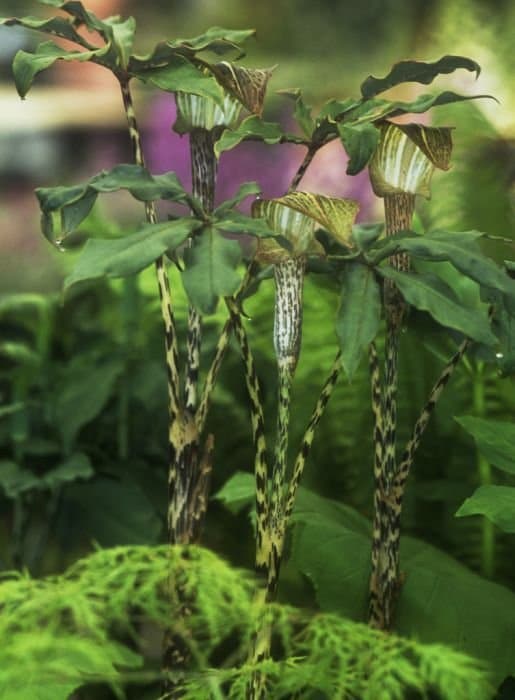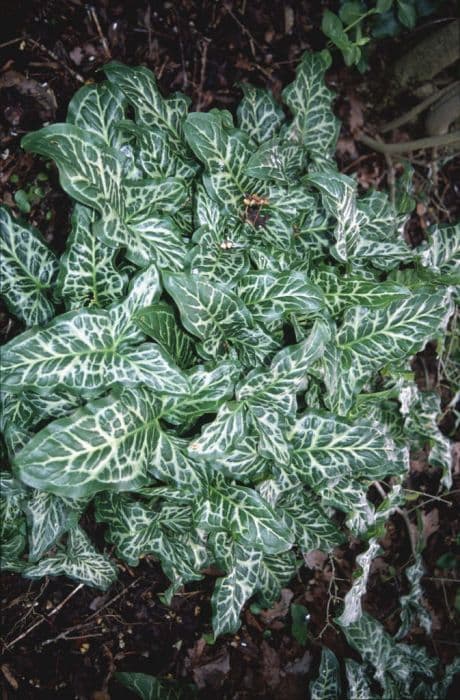Calla Lily 'Yelloween' Zantedeschia 'Yelloween'

ABOUT
The 'Yelloween' is a captivating plant with a vibrant and showy appearance. This variety is distinguished by its striking funnel-shaped flowers that are characterized by a bold yellow hue. The flowers are large and elegant, with a rolled or tubular spathe, which is often misidentified as the flower itself due to its prominence and colorful nature. The true flowers are small and clustered on a finger-like central spadix that is surrounded by the spathe. The leaves of this plant provide a lush background, with their deep green color and waxy texture. They are arrow-shaped or elongated-heart-shaped, with a glossy finish that adds to the overall aesthetics of the plant. When in bloom, the contrast between the bright yellow flowers and the verdant leaves creates a striking display. The 'Yelloween' emits a light fragrance, making it not only a feast for the eyes but also a gentle delight for the senses. It adds a pop of color to any garden space or floral arrangement, and despite its tropical origins, it has found popularity due to its visually appealing nature and relatively easy care requirements compared to other flowers of similar exotic appearance.
About this plant
 Names
NamesFamily
Araceae
Synonyms
Calla Lily, Arum Lily
Common names
Zantedeschia 'Yelloween'.
 Toxicity
ToxicityTo humans
The plant known as calla lily is considered toxic to humans. All parts of the calla lily contain calcium oxalate crystals which can cause irritation if ingested or if they come into contact with the skin or eyes. If someone ingests any part of the plant, they may experience symptoms such as a burning sensation in the mouth or throat, swelling of the lips, tongue and throat, difficulty swallowing, and possible nausea, vomiting, or diarrhea. Ingesting large amounts could lead to more severe symptoms, and seeking medical attention is advised.
To pets
The calla lily is also toxic to pets. It contains calcium oxalate crystals that can cause oral irritation, intense burning and irritation of the mouth, lips and tongue, excessive drooling, vomiting, and difficulty in swallowing if ingested. Pets may also paw at their mouth due to the discomfort. In severe cases, ingestion could lead to dehydration, a decrease in appetite, and other more serious symptoms depending on the amount ingested. If a pet ingests this plant, it is important to contact a veterinarian immediately.
 Characteristics
CharacteristicsLife cycle
Perennials
Foliage type
Evergreen
Color of leaves
Green
Flower color
Yellow
Height
2 feet (60 cm)
Spread
1 foot (30 cm)
Plant type
Herb
Hardiness zones
9
Native area
South Africa
Benefits
 General Benefits
General Benefits- Decorative Appeal: Zantedeschia 'Yelloween' or calla lily features striking yellow flowers that add a vibrant splash of color to any garden or bouquet.
- Low Maintenance: Calla lilies are relatively easy to care for, requiring minimal attention once established in the right conditions.
- Long Blooming: This plant has a long flowering season, providing beautiful blooms from late spring to early autumn.
- Versatile Landscaping: Calla lilies can be used in a variety of landscapes, including beds, borders, and as accent plants.
- Container Gardening: They are well-suited for containers, allowing them to be featured on patios, balconies, or indoors.
- Event Decor: Their elegant flowers are a popular choice for weddings and other events, providing natural décor.
- Wildlife Attractant: The blooms can attract beneficial insects like bees and butterflies to the garden.
 Medical Properties
Medical PropertiesThis plant is not used for medical purposes.
 Air-purifying Qualities
Air-purifying QualitiesThis plant is not specifically known for air purifying qualities.
 Other Uses
Other Uses- Zantedeschia 'Yelloween', commonly known as Calla Lily, can be used for natural fabric dye. The flowers can produce a range of yellow hues when used to dye fabrics like wool or silk.
- Calla Lily spathes can be crafted into unique and delicate jewelry. After being dried and treated, they can be transformed into pendants or earrings.
- The sturdy stalks of Calla Lilies can be incorporated into homemade papermaking, adding plant fibers and textures to the final product.
- With their striking appearance, Calla Lilies can be a compelling subject for botanical illustration and plant-based artwork creation.
- The plant parts, when dried, can be used in potpourri for adding volume and a slight vegetal scent, typically complemented with other aromatic herbs.
- Calla Lily leaves can be used in floral crafts, such as creating a natural canvas for painting or as a mold for concrete garden ornaments.
- The strong stems of Calla Lilies can be used as natural supports for other plants in gardens or greenhouses.
- When used as a centerpiece in a clear vase, the sliced stems of Calla Lilies create an interesting visual of the internal structure of plant stems.
- Calla Lilies can be used as educational tools in botany classes, illustrating plant structure, reproduction processes, and lifecycle.
- The shape and form of Calla Lily flowers can inspire design elements in architecture, fashion, and home decor, providing organic lines and symmetry.
Interesting Facts
 Feng Shui
Feng ShuiThe Calla Lily is not used in Feng Shui practice.
 Zodiac Sign Compitability
Zodiac Sign CompitabilityThe Calla Lily is not used in astrology practice.
 Plant Symbolism
Plant Symbolism- Renewal and rebirth: 'Yelloween', commonly known as Calla Lily, often symbolizes renewal and rebirth due to its bulb-based nature and ability to reemerge with vigor each growing season.
- Femininity and grace: The elegant shape and smooth lines of the Calla Lily are often associated with femininity and grace, making it a popular choice in celebratory occasions like weddings.
- Beauty: The striking appearance of the 'Yelloween' Calla Lily, especially its vibrant yellow color, represents beauty and is often given as a compliment to someone's looks.
- Purity and innocence: As with other white or light-colored flowers, the Calla Lily is commonly associated with purity and innocence, which is why it's often used in religious ceremonies and bridal bouquets.
- Overcoming challenges: The Calla Lily's ability to grow in a variety of conditions and to rise above the water in its natural habitat symbolizes triumph over challenges.
 Water
WaterThe Calla Lily 'Yelloween' should be watered generously during its growing season, ensuring the soil is kept moist but not soggy, generally about once per week. Each watering session should provide enough water to soak the soil thoroughly. Depending on the pot size and the environmental conditions, this might be approximately 16 to 24 ounces of water. During its dormant period in the winter, reduce watering to every few weeks, just enough to prevent the soil from completely drying out.
 Light
LightCalla Lily 'Yelloween' thrives in bright, indirect light but can also tolerate partial shade. The best spot is where the plant receives morning sunlight and shaded afternoon, especially in hotter climates. Avoid placing it in direct, harsh sunlight as it can scorch the leaves.
 Temperature
TemperatureCalla Lily 'Yelloween' prefers a temperature range between 60 and 75 degrees Fahrenheit for optimal growth. They can survive temperatures as low as 50 degrees Fahrenheit and as high as 85 degrees Fahrenheit. The ideal growing conditions are a consistent temperature around the preferred range without drastic fluctuations.
 Pruning
PruningPruning Calla Lily 'Yelloween' is mostly about removing spent flowers and yellowing leaves to encourage healthy growth and appearance. Trim these parts back to the base of the stem. Pruning is best done after flowering or when the foliage starts to decline, typically in late summer or early fall.
 Cleaning
CleaningAs needed
 Soil
SoilFor Calla Lily 'Yelloween', a well-draining soil mix is essential, with a pH range of 5.5 to 6.5. An ideal mix would include two parts peat moss, one part perlite, and one part loamy garden soil to ensure proper drainage and aeration. Regularly check the pH level to maintain the optimal acidity for this plant.
 Repotting
RepottingCalla Lily 'Yelloween' should be repotted every two years or when it becomes root-bound. Doing so in the spring can help the plant recover and grow more vigorously during its growing season.
 Humidity & Misting
Humidity & MistingCalla Lily 'Yelloween' prefers a humidity level between 60-70%. This plant thrives when the air around it replicates the humid conditions similar to its native environment.
 Suitable locations
Suitable locationsIndoor
Place Calla Lily 'Yelloween' in bright, indirect light indoors.
Outdoor
Grow Calla Lily 'Yelloween' in partial shade outdoors.
Hardiness zone
8-10 USDA
 Life cycle
Life cycleThe 'Yelloween' Calla Lily begins its life cycle when a dormant rhizome is planted in early spring after the last frost. The rhizome sprouts and produces a clump of large, arrow-shaped leaves and a tall, elegant flower stalk, which unfurls to reveal the plant's distinctive yellow funnel-shaped spadix and spathe. Following the flowering stage in summer, which can last several weeks, the plant sets seeds if successfully pollinated. As summer progresses into fall, the foliage begins to yellow and wither, signaling the plant's entrance into dormancy. The rhizome remains dormant over winter, conserving energy for the next growing season. With the return of favorable conditions in spring, the cycle begins anew with the rhizome producing new growth and the process repeating itself.
 Propogation
PropogationPropogation time
Spring-Early Summer
Zantedeschia 'Yelloween', commonly known as Calla Lily, can be propagated through division, which is the most popular method. This is best done when the plant is dormant, typically in autumn after the foliage has died back or in early spring before growth resumes. To propagate by division, carefully dig up the rhizomes and gently separate them, making sure each piece has at least one growth node. After dividing, the rhizomes should be planted immediately at a depth of about 4 inches (10 cm) in well-draining soil. Adequate spacing, usually about 12 inches (30 cm) apart, is essential to provide enough room for the new plants to grow. The divided rhizomes need to be kept moist but not waterlogged to encourage successful establishment and growth.









